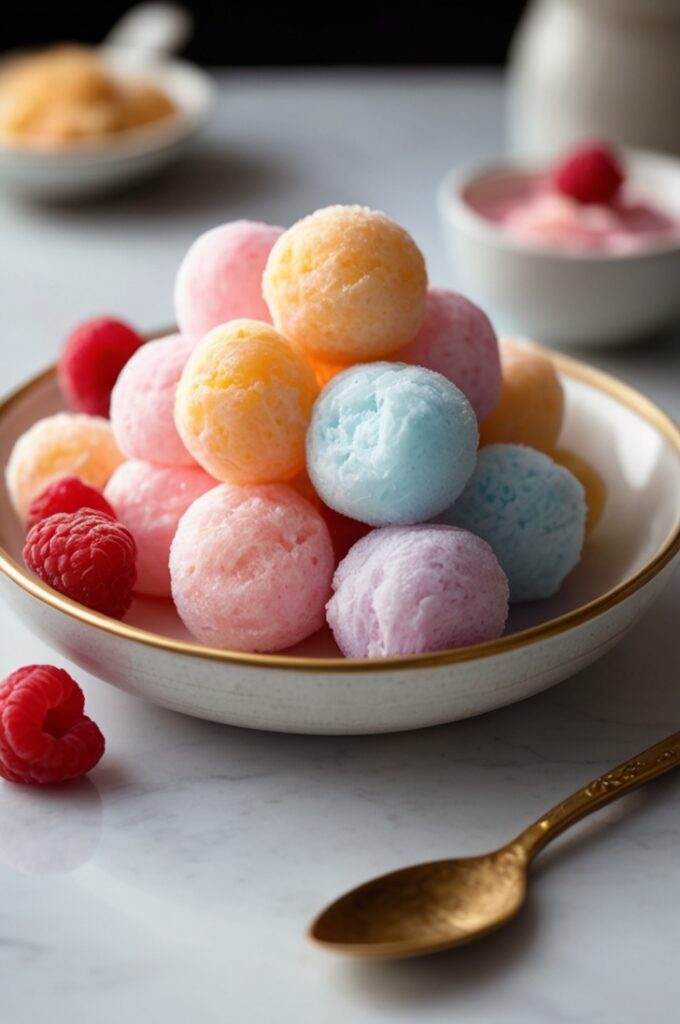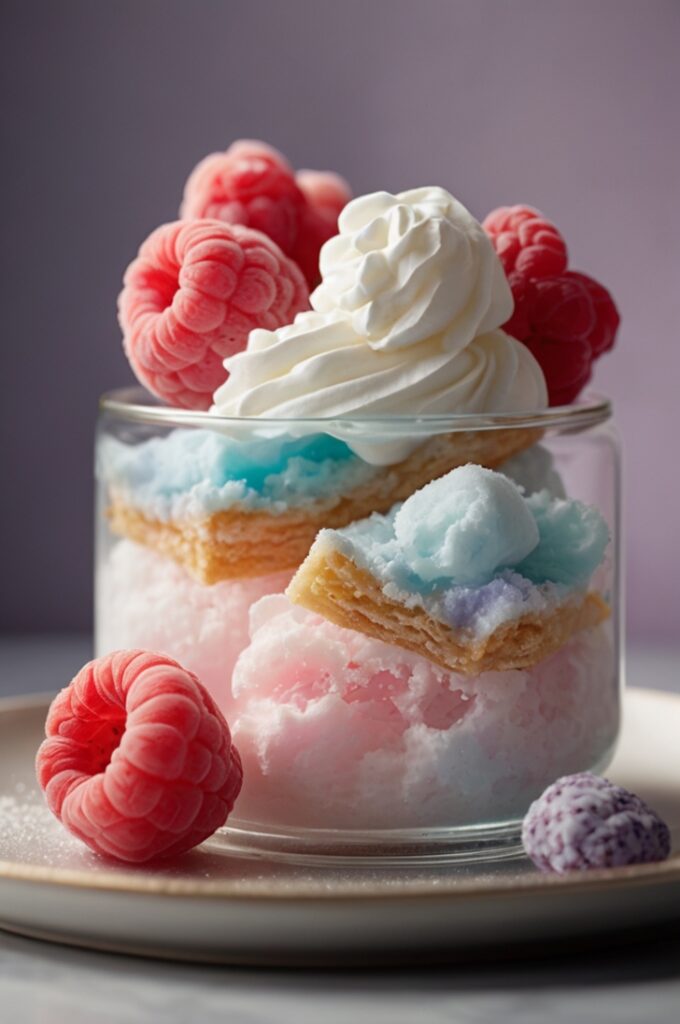I still remember the first time I attempted cotton candy in my grandmother’s kitchen. The sugar crystalized too quickly, burning my fingers and leaving a sticky disaster across her vintage countertops. Twenty years and countless iterations later, I’ve perfected what I now call “Cotton Candy Cloud Bites” – a sophisticated reimagining of carnival nostalgia that’s been featured in my restaurant’s tasting menu for three consecutive seasons.
These ethereal confections combine the nostalgic flavor of traditional cotton candy with modern culinary techniques to create an elevated dessert experience that literally melts in your mouth. They ain’t just pretty—they’re a textural revelation that challenges conventional dessert paradigms while remaining accessible to even novice pastry chefs.
Ingredients & Substitutions
For the Cotton Candy Base
- 2 cups granulated sugar (preferably ultra-fine)
- ½ cup light corn syrup
- ½ cup water
- ¼ teaspoon cream of tartar
- 1 teaspoon vanilla bean paste (or 2 teaspoons high-quality extract)
- Food coloring (preferably gel-based for vibrant hues)
For the Cloud Bite Structure
- 2 tablespoons unflavored gelatin powder
- ½ cup cold water (for blooming gelatin)
- 1 cup heavy whipping cream (36% fat content ideally)
- 3 large egg whites, room temperature
- ¼ teaspoon salt
- 2 tablespoons freeze-dried fruit powder of choice (strawberry, blueberry, or raspberry work exceptionly well)
For the Crystalline Coating
- 1 cup superfine sugar
- 2 tablespoons cotton candy flavoring (or flavoring of choice)
- 1 tablespoon edible pearl dust (optional but recommended for visual appeal)
High-quality ingredients make a remarkable difference in this recipe. The ultra-fine sugar dissolves more readily, preventing those pesky crystals that can ruin your cotton candy base. For those with dietary restrictions, agave nectar can replace corn syrup, though the result will be slightly less stable. Plant-based alternatives exist for gelatin (agar-agar at a 1:1 ratio), but you’ll need to adjust the setting temperature and expect a slightly different mouthfeel.
The freeze-dried fruit powder isnt just for flavor—it contributes crucial acidity that balances the sweetness while enhancing the overall flavor profile. If unavailable, citric acid powder (about ¼ teaspoon) mixed with your preferred flavor extract can serve as a workable substitute.
Step-by-Step Instructions

Preparing the Cotton Candy Base
- Combine sugar, corn syrup, water, and cream of tartar in a heavy-bottomed saucepan. The cream of tartar prevents unwanted crystallization during the heating process—don’t skip it, even if your tempted.
- Attach a candy thermometer to the side of your pan and heat the mixture over medium-high heat, without stirring, until it reaches 320°F (160°C). This temperature precision is crucial—too low and your mixture won’t spin properly; too high and you’ll develop bitter burnt notes.
- Remove from heat immediately and carefully stir in vanilla and your chosen food coloring. Be cautious during this step as the mixture will bubble vigorously. Let cool for precisely 3 minutes—enough to handle safely but not enough to harden.
Creating the Cloud Structure
- While your candy base is cooking, bloom gelatin by sprinkling it over cold water in a small bowl. Allow it to sit undisturbed for 5 minutes until fully absorbed and resembling a soft, translucent gel.
- Whip heavy cream to soft peaks in a chilled metal bowl. Keep it cold in the refrigerator until needed. Many chef’s underestimate the importance of temperature control here—warm equipment can prevent proper incorporation of air.
- In a separate clean, dry bowl, beat egg whites with salt until foamy. Gradually increase speed and continue beating until stiff peaks form. The whites should appear glossy and hold their shape when the beater is lifted.
- Heat bloomed gelatin in the microwave for 10-15 seconds or over a double boiler until fully melted but not hot. A common mistake is overheating, which destroys gelatin’s setting properties.
- Working quickly, fold melted gelatin into whipped cream using a gentle figure-eight motion. Then fold in one-third of the egg whites to lighten the mixture before incorporating the remainder. Finally, fold in the freeze-dried fruit powder until just combined.
Forming the Cloud Bites
- Transfer the cloud mixture to a piping bag fitted with a round tip (approximately 1-inch diameter). Pipe 2-inch rounds onto a silicone mat-lined baking sheet. For consistent sizing, you might draw template circles on parchment paper, then flip it over beneath the silicone mat.
- Place the piped clouds in the freezer for 20 minutes to set slightly. They should be firm enough to handle but not frozen solid. This half-frozen state makes the next step significantly easier.
- Meanwhile, prepare your cotton candy base for spinning. If it has hardened, reheat briefly just until fluid. Using a special cotton candy spinning tool (or a clean, sanitized whisk with cut-off ends), dip into the hot candy mixture and quickly wave it over and around each cloud bite, creating delicate strands of spun sugar.
- Allow the completed cloud bites to set at room temperature for 30 minutes before proceeding to the final coating. This resting period allows the textures to harmonize and the gelatin to fully set.
Applying the Crystalline Coating
- Combine superfine sugar with cotton candy flavoring in a shallow dish, mixing thoroughly with your fingertips to ensure even distribution. Add pearl dust if using, which creates that signature shimmer reminiscent of authentic carnival cotton candy.
- Gently roll each cloud bite in the flavored sugar mixture, applying just enough pressure to coat without compressing the delicate structure. If the coating isn’t adhering properly, very lightly mist the bites with water using a fine spray bottle.
- Place finished bites on a wire rack and allow them to dry completely, approximately 1-2 hours. During this time, the exterior develops a delicate crystalline shell while maintaining the cloud-like interior—this contrast is what makes these bites extraordinary.
Cooking Techniques & Science
The magic of Cotton Candy Cloud Bites lies in the intersection of multiple confectionery techniques. Traditional cotton candy relies on centrifugal force to create thin strands as molten sugar passes through tiny holes. We’re adapting this principle on a smaller scale, creating microscopically thin sugar filaments that encase our cloud structure.
Temperature precision is absolutely critical throughout this process. Sugar behavior changes dramatically at different heat points—at 320°F (160°C), sugar reaches what confectioners call the “hard crack” stage. At this precise temperature, the sugar has less than 1% moisture remaining, allowing it to form brittle structures that shatter pleasingly against the soft interior.
The cloud structure itself employs a modified stabilized mousse technique. The gelatin provides structural integrity, while whipped cream and egg whites create microscopic air pockets that give the distinctive melt-in-your-mouth quality. The science here involves protein denaturation in the egg whites forming a stable network that traps air bubbles—essentially creating edible foam.
Our freeze-dried fruit powder serves multiple functions beyond flavor: the particulate matter provides nucleation sites for sugar crystallization during coating, while the natural fruit acids interact with sugar molecules to create more complex flavor compounds through subtle caramelization reactions.
Humidity is your nemesis when crafting these bites. Sugar is hygroscopic (attracting water molecules from the air), which can cause your carefully spun sugar to collapse. Ideally, work in a climate-controlled environment with humidity below 35%. If this isnt possible, consider running a dehumidifier in your kitchen for several hours before beginning the recipe.
Serving & Pairing Suggestions
Cotton Candy Cloud Bites present a stunning visual display when arranged in a cascade formation on a dark slate or mirror platter. The height differential creates dramatic shadows that enhance their ethereal appearance. For maximum impact, serve them on warmed plates (about 100°F) to create a gentle upward draft that subtly moves the delicate sugar strands.

A light dusting of additional pearl dust just before serving creates a captivating shimmer under dining room lighting. For special occasions, consider affixing a thin strand of edible gold or silver leaf to each bite—the metallic element provides stunning contrast against the pastel-colored cotton candy exterior.
These bites pair exceptionally well with:
- A brut rosé champagne, whose acidity cuts through the sweetness while complementing the fruity notes
- A vintage dessert wine like Sauternes, creating a fascinating interplay between two distinct types of sweetness
- For non-alcoholic pairings, consider a tart berry tea served over ice or a cucumber-mint infused sparkling water
As part of a larger dessert offering, these bites work brilliantly alongside contrasting textures—perhaps a quenelle of dark chocolate ganache or a small pool of passionfruit curd. The temperature contrast between a warm element and the room-temperature cloud bite creates an intriguing sensory experience.
Conclusion
Cotton Candy Cloud Bites represent the perfect marriage of nostalgic flavor and sophisticated technique. Their deceptive simplicity belies the precision required to achieve that signature juxtaposition of textures—the gossamer-thin sugar exterior yielding to the ethereal cloud-like center.
While technically demanding, mastering these bites provides an invaluable addition to any pastry chef’s repertoire. The techniques employed here—sugar spinning, stabilized mousse production, and flavor-infused crystallization—transfer readily to countless other applications across the dessert spectrum.
Don’t be discouraged by initial attempts that might fall short of perfection. Sugar work improves dramatically with practice, and even “failed” batches remain delicious. The most common pitfall is rushing the process; each stage requires its dedicated time to develop proper structure. With patience and attention to detail, you’ll soon be creating these magical bites that quite literally melt away, leaving only the memory of cotton candy clouds dancing across your guests’ palates.
FAQs
Why did my cotton candy strands become sticky shortly after making them?
Humidity is the likely culprit. Sugar is extremely hygroscopic, meaning it attracts moisture from the air. Work in a low-humidity environment and store finished bites in airtight containers with silica gel packets to maintain texture.
Can I make these in advance for a catering event?
Cotton Candy Cloud Bites are best made no more than 8 hours before serving. However, you can prepare the cloud structure up to 2 days ahead and apply the cotton candy exterior and crystalline coating the day of service. Store unfinished components in airtight containers in the refrigerator.
My cotton candy isn’t forming thin strands but rather clumps. What am I doing wrong?
Your sugar mixture has likely cooled too much. It must be at the precise temperature where it’s fluid enough to spin but cool enough not to burn. If it’s hardening, reheat it gently until just pourable, then continue spinning. Additionally, ensure your spinning tool is properly designed—improvised tools might not create the centrifugal force needed.
How can I create multiple colors in one bite?
Divide your sugar mixture into separate batches before adding coloring. Work quickly to spin different colored strands around each cloud base, rotating as you go. This technique requires practice but creates a stunning rainbow effect that elevates the presentation significantly.
Is there a way to reduce the overall sweetness without compromising the structure?
Incorporate additional acid elements like increased freeze-dried fruit powder or a small amount of citric acid in your cloud base. The acidity balances perceived sweetness without affecting the chemical properties needed for successful cotton candy formation. You might also experiment with salt varieties like fleur de sel as a finishing element—the contrast enhances flavor complexity while reducing sweetness perception.

